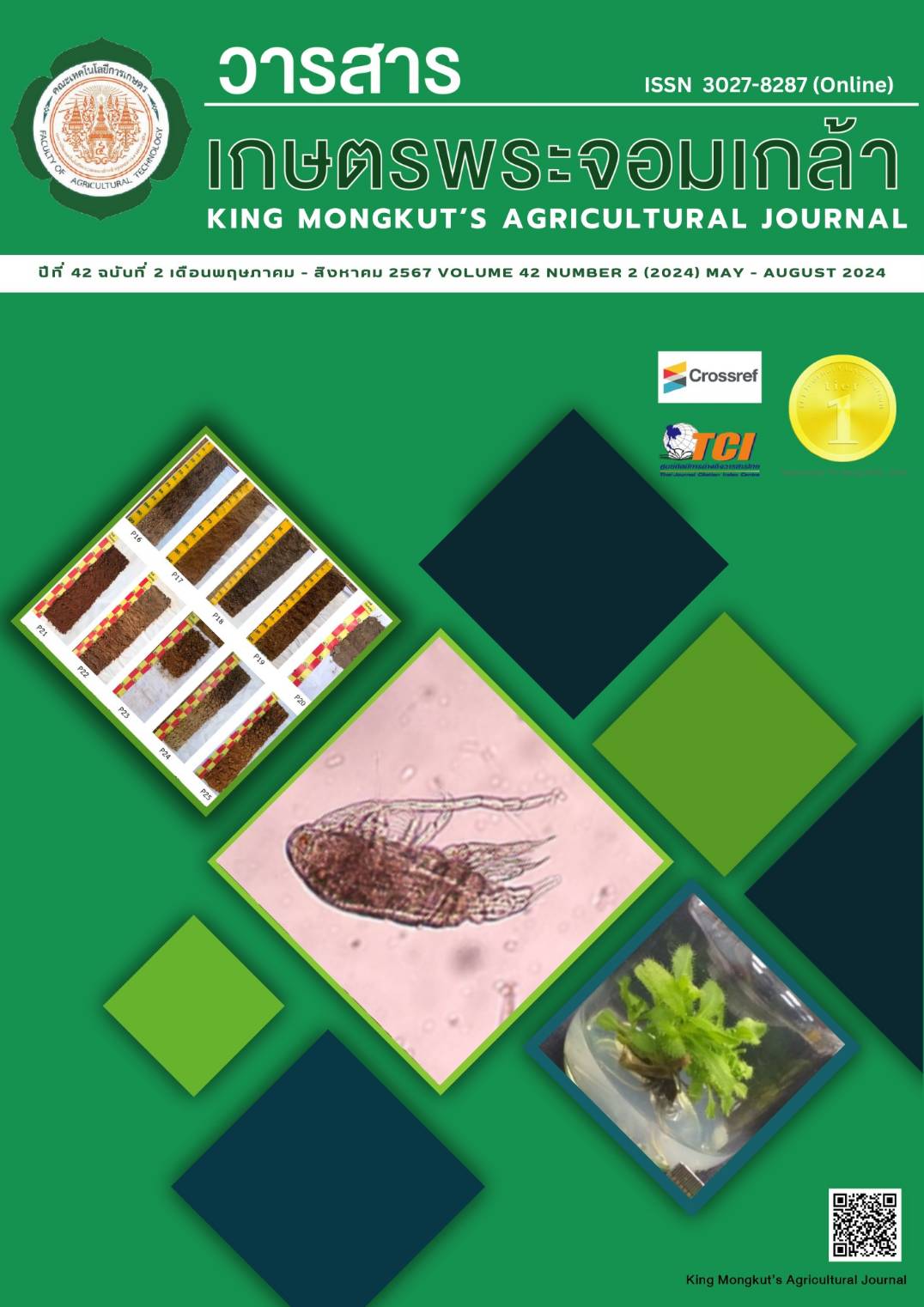Effects of Chitooligosaccharide on Growth and Yield of Lettuce (Lactuca sativa L.) cv. Green Cos
Main Article Content
Abstract
The effects of chitooligosaccharides (COS) on growth and yield of greencos salad were studied. The experimental design was 3×2 Factorial in Completely Randomized Design (CRD) with 2 factors: Factor 1 was concentration of COS at 1, 2 and 4 ml/L and Factor 2 was administration of COS at 7 and 14 days after planting together with the control (no chitooligosaccharides) using 4 replications. The results showed that COS administration at the rate of 4 ml/L and spraying every 14 days gave the highest fresh weight of greencos salad (134.78 g) when compared to COS at the rate of 4 ml/L and spraying every 7 days, COS administration at the rate of 2 ml/L and spraying every 7 and 14 days and COS 1 ml/L and spraying every 7 and 14 days, respectively. The control (no COS) gave the minimum fresh weight of 91.87 g.
Article Details

This work is licensed under a Creative Commons Attribution-NonCommercial-NoDerivatives 4.0 International License.
King Mongkut's Agricultural Journal
References
Anonymous. (2017). Green Cos by BioBonics. Retrieved from: https://biobonics.com/green-cos-by-biobonics. (in Thai).
Boonlertnirun, S., Suvarnnasara, R., & Boonlertnirun, K. (2013). Application of chitosan in combination with nitrogen fertilizer in rice production. In Proceedings of the 53th Kasetsart University, pp.687-694. Kasetsart University. (in Thai).
Brady, N. C., & Weil, R. R. (2008). Soil colloids: seat of soil chemical and physical acidity. In N. C. Brady and R. R. Weil, ed., The Nature and Properties of Soils, pp. 311-358. Pearson Education Inc.
Chakhatrakan, S., & Yenjai, K. (2006). Effect of Oligochaitosan on Growth and Yield of Lactuca Sativa Grown under Hydroponics System. Thai Science and Technology Journal, 14(1), 16-24. (in Thai).
Green Innovative Biotechnology. (2016). Product Green Innovative Biotechnology. Retrieved from: http://www.gib.co.th. (in Thai).
Jirakiattikul, Y., & Saelim, N. (2009). Growth of Leaf Lettuce cv. Red Oak Grown in Hydroponics with Different Nutrient Solutions. Thai Science and Technology Journal, 17(2), 81-88. (in Thai).
Khongthong, S. (2009). Chitin-Chitosan. Journal of Industrial Education, 1, 1-3. (in Thai).
Kotsaeng, N., & Chompusaen, P. (2013). Effects of Chitosan on Chinese Kale Growth. In Proceedings of the 9th Mahasarakham University Conference: Research to the ASEAN Community 2nd, pp.305-478. Mahasarakham University. (in Thai).
National Statistical Office. (2019). Agricultural Change Survey 2018. Retrieved from: https://gnews.apps.go.th/news?news=44164. (in Thai).
Piyasirananda, P. (2002). Growing Vegetables by Reducing the Use of Chemicals. Retrieved from: http://www.ldd.go.th/Lddwebsite/web_ord/Technical/pdf/P_Technical10017.pdf. (in Thai).
Srisathit, R. (2015). Appropriate Technologies for Safe Vegetable Production in the Central, the West and the Upper Northeast Thailand. Retrieved from: https://www.doa.go.th/research/attachment.php?aid=2261. (in Thai).
Rabea, E. I., Badawy, M. E. T., Stevens, C. V., Smagghe, G., & Steurbaut, W. (2003). Chitosan as antimicrobial agent: applications and mode of action. Biomacromolecules, 4(6), 1457-1465.
Ramirez, M. A., Rodriguez, A. T., Alfonso, L., & Peniche, C. (2010). Chitin and its derivatives as biopolymers with potential applications. Biotecnologia Aplicada, 27(4), 270-276.


